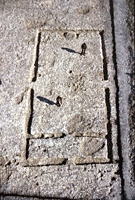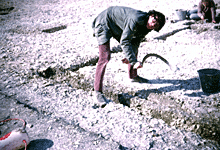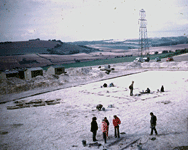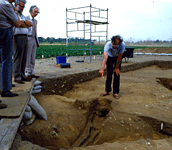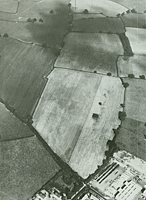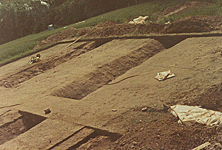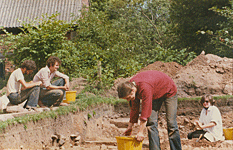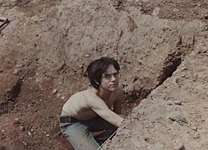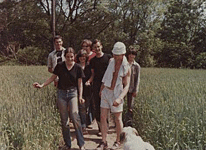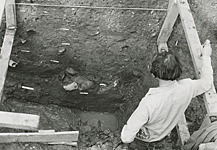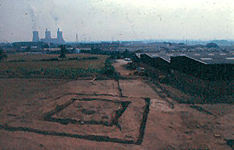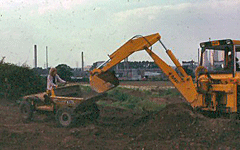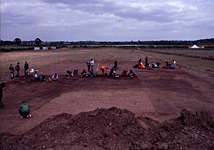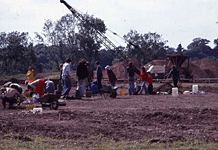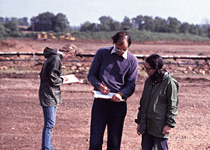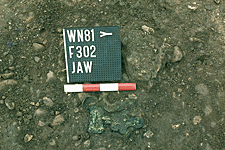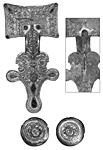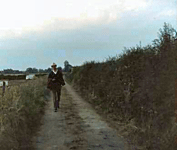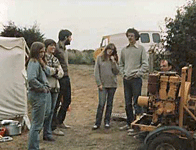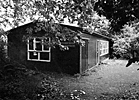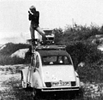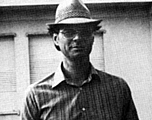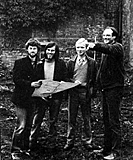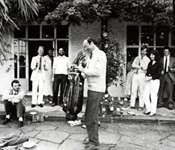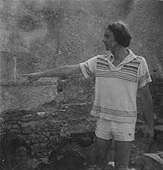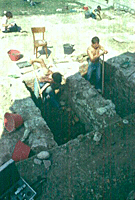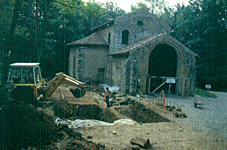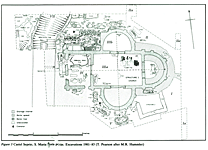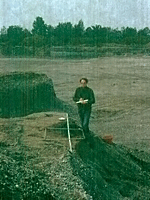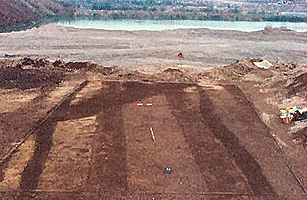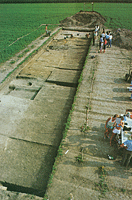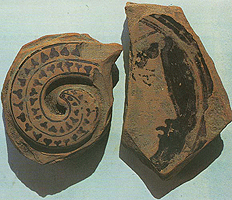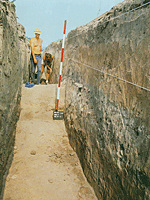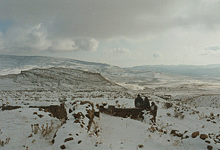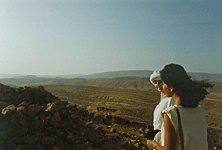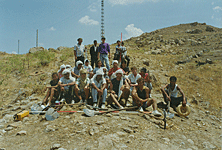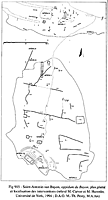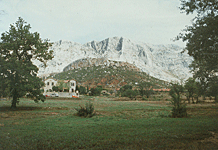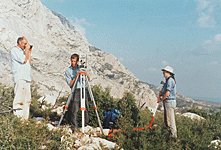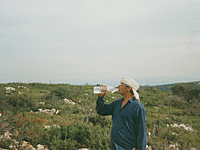Field Archaeology
Excavations in Britain, Italy, Algeria and France
Contents:
Outside towns, excavations, and increasingly integrated fieldwork projects, brought Martin to more rural settings, starting with Peter Addyman's excavations at Chalton. The approach developed in towns matured over the course of these projects, leading to a substantial body of publications which advocate a staged approach to field archaeology. Generations of students who have taken Martin's Field Research Procedure course or been in the field with him will recognise this approach. They will also recognise the discipline of a Carver excavation in small details: spoil heaps under control, strings straight, trowelling lines marshalled. But there was always time for lively debate and an active scene off-site.
Chalton
Peter Addyman writes:
Martin Carver's first time with the Saxons
"I can't remember how Captain M.O.H. Carver found out about the University of Southampton's 1970s dig on the top of the chalk down at Chalton in Hampshire but he turned up offering, as so many do, little experience of archaeology but an enthusiastic willingness to work. He was about to exchange a military career for something else, he wasn't quite sure what, and loosening family ties gave him unlimited scope.
Military training prepares you for anything and Martin soon found archaeology an attractive version of anything. At least as represented by the black-on-white features of the Chalton Saxon settlement, it seemed a doddle and he soon found himself a site supervisor in charge of the excavation of Structure 21.
Structure 21 was an extremely bad structure for a tyro to start on. With clearly visible foundation trenches precisely cut into bright virgin chalk all filled with dark humic material it posed absolutely no archaeological or interpretational problems whatsoever. To give him his due, Martin excavated it impeccably, but the experience must have given him the impression that Anglo-Saxon archaeology was going to be easy.
Martin grasped the opportunities provided by the après-dig culture at Chalton, soaking up the enthusiasms and expertise of a number of up-and-coming young Anglo-Saxonists and before long was asking how he could break into a career in Anglo-Saxon archaeology. I pointed him at Rosemary Cramp's post-graduate courses at Durham - and conned him into coming to York with me to get different experience in the more challenging conditions of a deeply stratified urban site (see Carving up Bishophill) where things were not black-on-white but emphatically black-on-black."
PETER ADDYMAN
Catherine Hills writes:
"I met Martin in August 1972 when we were both site supervisors at Chalton, an Anglo-Saxon settlement site in Hampshire excavated by Peter Addyman (and later by Tim Champion). This was a chalky hill, occupation levels long ploughed away (though pottery was recovered by a schoolboy, a certain Barry Cunliffe). The buildings survived as rectangles of postholes packed with chalk and flints - except for Martin's building, which was post-in-trench, a construction then new to us. At Yeavering Hope-Taylor had already excavated more complex buildings but these were not then published and so not widely known.
It seemed that we needed concrete evidence to persuade others of the reality of this phenomenon, and a section of the trench, showing the post sockets, was preserved for posterity. Martin sprayed it with plastic and sliced off the resulting solid plank of chalk and soil, as shown in the picture. Is it still languishing in a store room in Southampton?
The most dramatic event of that season was the fire in the middle of the night which burnt down the barn where most of us were sleeping - we all got out OK. Martin was living locally with his family and turned up with blankets next morning.
Later I saw him up a ladder drawing stones at Deerhurst, in a caravan in a cemetery in York and at Sutton Hoo where I was one of the committee which regularly came for a day out, ending with one of Martin's brilliant site tours. And even in the farthest north at Tarbat where he lured us for a seminar last year.
Where next? "
CATHERINE HILLS
Reference (MOHC bibliography)
- 1973. Documentary sources for the topography of the Chalton area. Appendix in P.V. Addyman & D. Leigh: The Anglo-Saxon village at Chalton, Hampshire: second interim report. Medieval Archaeology 17 (1973): 20-25.
Shropshire: Ludlow and Castle Farm, Shifnal
While evaluating the urban fabric at Shrewsbury it was inevitable that there would be the need to respond to other 'rescue' situations in rural Shropshire, for example at Ludlow (traces of Beaker and Romano-British occupation on the site shown in an air photograph here) and at Castle Farm, Shifnal, near the new town of Telford.
There the imminent construction of a reservoir targeted a hillfort, published with another of Martin's early students and lifelong friend, Annette Roe (shown here with Malcolm Cooper, Mark Taylor and Jenny Glazebrook). The summer of 1980 was incredibly wet, and the team sheltering in the derelict Castle Farm developed cabin fever to a fairly alarming extent. Nevertheless, standards on site remained high. Once again, the results were integrated into a volume giving the wider view, a collection entitled Prehistory in Lowland Shropshire (1991).
The team photograph shows Jenny Glazebrook, ?, Annette Roe, Lawrence Bowkett, Charles Parry, Andrew Brooker-Carey and Jay Carver, also depicted in one of the Castle Farm ditches (photograph Emma Carver).
Annette Roe writes about Castle Farm:
"This was an Iron Age hill fort and medieval moated site {Martin is photographed here contemplating the section of the moat} destined to be flooded by Severn Trent Water to create a balancing reservoir which would regulate water around the new town of Telford. I was one of the lucky four that year in 1980 to be part of Martin's 'Year Out' programme at Birmingham University. He even rang my parents to persuade them that a year out was not a year off! It most certainly was not, and under Martin's leadership we all wanted to work as hard as he did. This was my first big chance to supervise a comparatively large site which turned out to be a huge challenge archaeologically, a student training dig and the basis for my MA dissertation. As always there was a great sense of camaraderie and later, as Martin became busier with other projects, I realised how lucky I was to have been his apprentice on site and, in retrospect, how brave and generous he was in allowing me to take my own decisions."
Annette also contributes this passage relating to another Shropshire site, the Carmelite Friary at Ludlow:
"This wonderful site was not only interesting archaeologically but it was excavated using Manpower Services staff chosen from the unemployed of Birmingham. Although the staff were funded by the government, everything else had to be paid for through fund-raising. We organised open days, a public viewing platform, talks to every conceivable local society and a student training dig for the University of Birmingham. I had then (and still have) a natural reticence to speak in public so I looked to my great hero of lectures and public speaking and asked when it would get easier. The answer was never - you just understand better how nervous you're going to be!"
ANNETTE ROE
Reference (MOHC bibliography)
- 1980 (with A. Roe & M.A. Cooper). Excavation and survey at Castle Farm, Shropshire: an interim report. West Midlands Archaeology 23: 40-51.
- 1991 (ed.). Prehistory in Lowland Shropshire (Transactions of the Shropshire Archaeological and Historical Society 67).
- 1991 (with A. Roe). Excavations at Castle Farm, Shifnal, 1980, in M.O.H. Carver (ed.) Prehistory in Lowland Shropshire (Transactions of the Shropshire Archaeological and Historical Society 67).
- 1991. A Strategy for Lowland Shropshire, in Prehistory in Lowland Shropshire (Transactions of the Shropshire Archaeological and Historical Society 67): 1-8.
- 1991 (with M.R. Hummler). Excavations at Rock Green, Ludlow, 1975, in Prehistory in Lowland Shropshire (Transactions of the Shropshire Archaeological and Historical Society 67): 84-97).
Warwickshire: Coleshill and Wasperton
In 1977-78 Coleshill on the outskirts of Birmingham became the focus of attention. There, the discovery of a Romano-British temple preceded the development of the site into light industrial and residential units. Consequently, Martin and students - Liz Hooper in particular - on the 'year out' training programme that later became one of the hallmarks of BUFAU (Birmingham University Field Archaeology Unit, now Birmingham archaeology) undertook the uncovering of the temple and precinct. Coleshill also marked the beginning of formal University training excavations, a tradition carried out for over 25 years by Martin in collaboration with Madeleine Hummler.
Never short of initiative, Martin managed to persuade Massey Ferguson, based in Stoneleigh, to lend him a mechanical excavator, allow him to drive it to Coleshill and train him to use it, as shown in this picture (though Martin is barely visible in the cab). The project was subsequently passed on to North Warwickshire Borough Council and John Magilton who continued excavations. They were published in 2006, with rather scant recognition for the work done in the early days of the project. On Carver's side, warm gratitude is due to Roy and Faith Jerromes, first encountered at Coleshill, at the beginning of a long-term collaboration at Sutton Hoo and Tarbat.
Faith and Roy Jerromes write:
"In 1978 Roy was introduced to field archaeology at a Romano-British temple site in Coleshill, Warwickshire and met the archaeologist in charge Martin Carver then of Birmingham University. With Martin's enthusiasm and guidance plus help from the others on site Roy soon became totally 'hooked'. I was volunteered by Roy to do some 'pot washing' and met Martin, little knowing how much of an enjoyable and life-changing impact he was to have on our summers for years to come. Even though I did not visit the Coleshill site as much as Roy I thoroughly enjoyed my time there. One thing I became aware of, and which has never failed to amaze me since I have known him, is Martin's ability to bring a site alive to those with little or no knowledge of archaeology; he does this with enthusiasm and humour. Encouraging interest and a need to know and learn more.
Over the years at Sutton Hoo and later at Tarbat we saw many sides of his character: he is great at a party, has an immense vocabulary of songs (very useful for singing round a bonfire etc.), but we also remember watching him from our caravan widow 'striding forth' over the mist-covered burial mounds at Sutton Hoo in the very early morning to check the site before anyone else was up. He obviously worried about some of the differing points of view of those who also had some say in the sites (his teams were always supportive) and here his diplomatic skills came to the fore. He often started work very early in the morning and would return late after a pub run to his computer. His charm is legendary and he can be extremely kind. But enough! We would hate to make him sound boring and saint-like. He's not: just an extremely likeable gentleman and friend.
We looked foreword to the 'dig' each year. I (Roy) for all that time spent doing something that I truly loved and I(Faith) to see and work with our summer family.
Our thanks to you Martin and also Maddy and your family. We wish you a happy, healthy, busy and enjoyable retirement."
FAITH AND ROY JERROMES
Reference: see Magilton, J. 2006. A Romano-Celtic temple and settlement at Grimstock Hill, Coleshill, Warwickshire (Transactions of the Birmingham & Warwickshire Archaeological Society, 110). Birmingham & Warwickshire Archaeological Society.
Wasperton
Extensive gravel extraction works on the Warwickshire Avon were the setting for large scale interventions in 1981 and later, initiated by Martin who brought the Birmingham 'year out' students and field school to the site. This multiperiod, prehistoric, Romano-British and Anglo-Saxon occupation and cemetery site was excavated as part of a large team effort, where Simon Buteux, Gill Crawford and many others at Warwickshire County Council and Museum participated. The cemetery is of particular importance for the Roman, post-Roman transition, and Anglo-Saxon periods. Its final publication went to press in 2008, a collaboration with Jonathan Scheschkewitz, Catherine Hills and others. Jonathan's thesis on Wasperton was the result of a successful collaboration between the Universities of Kiel and York, achieved with Professor Michael Müller-Wille's (whom Martin presented as an honorary graduand of the University of York) unstinting support.
Emma Carver contributed the photograph of Martin on the track at Wasperton and the team shot showing Sarah Bazalgette, Liz Hooper, Roy Hooper, Louise Dilworth (later Brooker-Carey), Malcolm Cooper and Martin.
Simon Buteux, who took over, with others, the reins at Birmingham University Field Archaeology Unit (BUFAU, now Birmingham Archaeology) was an undergraduate at Wasperton, writing his final year dissertation on aspects of the prehistoric site. He recalls:
Martin Carver and BUFAU
"Just one of many turning points in Martin's career, but the best thing that ever happened for archaeology at Birmingham University, was when Martin set up BUFAU.
The idea of setting up a field archaeology unit at Birmingham University grew out of discussions in the mid 1970s between the former West Midlands Rescue Archaeology Committee (WEMRAC) and the Department of Ancient History and Archaeology at the University. So, in 1976, Martin established Birmingham University Field Archaeology Unit (BUFAU). Initially it had just one salaried member of staff: Martin was employed as a Research Fellow in the Department of Ancient History and Archaeology, sponsored by the Department of the Environment. The rest of the BUFAU staff in the early days was a handful of undergraduatest who had elected to do an 'intercalated year of practical training' between their second and third years. I was one of last three undergraduates to do this 'year out' in 1980-81. We lived on our 'maintenance grants', for those old enough to remember such wonderful things. The 'training' consisted of learning 'on the job' with Martin, but it was the most useful and enjoyable year of my career.
The base for the Unit then was 'The Hut' in the garden of Selly Wick House, one of the University's off-campus properties (it was literally a hut - no toilets but plenty of bushes - and we managed to have some pretty riotous parties in it). The only vehicle the Unit had was a share in the use of the departmental Landrover (also shared with History and the cause of endless disputes) and an old Citroën 2CV belonging to Martin's Swiss partner, Madeleine.
The main remit of BUFAU was to carry out rescue excavations in the West Midlands, but from the outset Martin had bigger ideas and I spent much of my year out in a gravel quarry in Northern Italy [see Casalmoro]. As usual, the entire team and all the equipment were somehow squeezed into Mad's 2CV (most of the seats were removed and we sat on the equipment; it also doubled as a photographic tower).
Martin was larger than life, and it was incredibly stimulating but challenging to work for him. 'Normal working hours' and 'weekends' were concepts that were alien to Martin (the 'Carver Sunday morning lie-in' meant starting on site at 8.30 instead of 8.00). But at the end of a very long day Martin would bring out the whisky bottle and we didn't go to bed till we'd finished it, invariably in tears of laughter. Martin was viewed by his colleagues in Ancient History and Archaeology as a maverick (not entirely without justification), and possibly dangerous. You either loved him or hated him; I was in the former camp.
BUFAU soon grew and by the early 1980s funding for some big excavations came from the Manpower Services Commission (MSC), set up to tackle (or massage) the problem of unemployment. This transformed the Unit, which now had dozens of staff (here, from left to right, Mark Taylor, Jon Cane and Andrew Brooker-Carey with Martin at Stafford; nobody is posing). It included an illustration and display team, a manager and a secretary. The Unit moved from The Hut to somewhat grander premises on campus. Instead of the undergraduate 'year out' Martin now ran a postgraduate Diploma and MA in Practical Archaeology, but still very much based on the type of 'on-the-job' apprenticeship that had characterised the 'year out'.
Amongst the major excavations which Martin directed in the early 1980s were the Stafford Project and the Wasperton Project (everybody started calling excavations 'projects' at this time) which I was fortunate to be involved in. Unexpectedly Wasperton also turned up a spectacular Anglo-Saxon cemetery.
In 1982 BUFAU became involved in its first really prestigious project: Martin was appointed to direct the Sutton Hoo Research Project. Birmingham couldn't hold him now, and in 1986 Martin succeeded Philip Rahtz to the chair of archaeology at York, taking the Sutton Hoo project with him. Martin's departure marked the end of an era for BUFAU (he is shown in this photograph receiving his leaving present at a party held in the University's botanic gardens; did he ever use those golf clubs?). Martin had devoted ten years of his life to it. His legacy, however, is one of the most innovative and thriving university-based archaeology units in Britain, now Birmingham Archaeology."
SIMON BUTEUX
Reference (MOHC bibliography)
- In press 2008 (with Jonathan Scheschkewitz & Catherine Hills). Wasperton: a Roman, British and Anglo-Saxon community in central England. Woodbridge: Boydell.
Italy: Manerba and Castelseprio
Martin's introduction to Italy is owed in the first place to Lawrence Barfield, eminent prehistorian of Italy, who was conducting an excavation at the Chalcolithic site of the Sasso di Manerba on the shores of Lake Garda in the late 70s. This in turn led to an excavation, by Martin and a team from the Università Cattolica di Milano and Birmingham University at the church of the Pieve di Manerba. Emma Carver, now Head of Interpretation at English Heritage, was part of the party and contributes this photograph of Martin giving a site tour at the Pieve. She writes:
"Martin's site tours have always been an important part of any excavation whether you be a tourist, passer by, seasoned digger or a member of his family. He has that rare gift of making the past seem accessible and, perhaps most crucially, relevant to people's lives - an interpreter through and through. A remark that has always stayed with me, probably made as a retort to my not wanting to do my history homework: 'How can the past be boring - it's always about people' sums up his endless enthusiasm to unearth some of those people and to re-tell their stories in the present.
Dad - long may you remain my greatest source of inspiration. Happy retirement!"
EMMA
Annette Roe pursued a career in archaeology in Italy, before returning to contract archaeology in Britain. She writes this tribute, part inspired by work at Manerba:
A legacy and a career in song
"Martin has given a great deal to those of us who have worked with him over the years. Principal among these are his enthusiasm for archaeology and his belief that we should all be working to the same end, whether we work in the commercial, curatorial or academic sector. He has also provided us with a set of tools and principles to work with. His hierarchical recording system and his stratification diagram are the best I have ever worked with. This system, developed and in the late 1970s and continually updated and adapted, made recording logical, allowing you to organise your data and your thoughts and to 'see' your site when writing up. I introduced this system wherever I could and even participated in a lesson at the Università Cattolica in Milan where I presented Martin's stratification diagram in a duel against my colleague, Brunella Bruno, who was teaching the Harris matrix. Needless to say the students preferred Martin's method.
In all the years I have worked with Martin, for every site I have a memory in song. From Castle Farm when we all sang 'and so this is Shifnal and what have we done' to the tune of John Lennon's Christmas song, to Pieve Manerba [depicted here] when the Italian diggers wrote a song especially for him 'con badile, cazzuola e carriola, quando Martin ci invita d'agir...' Martin has always introduced music and song to our evenings and work time. Apart from his hugely eclectic taste for different types of music and his flute playing for relaxation, he has always been interested in 'collecting' songs from around the world. He and Madeleine would sing French songs to us, he would sing songs in Russian, Italian folk songs and anthems, and a variety of songs learnt and practiced over the years that we would all sing and enjoy around camp fires on many an occasion on different sites. As his sites attracted students and volunteers from all over the world, the evenings of song brought down barriers between those who spoke different languages and created bonds between them which may not otherwise have been possible."
ANNETTE ROE
At Manerba Martin met Gian-Pietro Brogiolo, now Professor of medieval archaeology at the University of Padova, and a fruitful partnership developed, leading to the excavations of two early medieval ecclesiastic site: the Pieve di Manerba on Lake Garda and Santa Maria foris portas at Castelseprio in the province of Varese. The latter proved to be Carolingian rather than earlier, inscribed into the late/sub Roman castrum and Borgo of Castelseprio. Martin's love of Italy and Italians, and his influence over the course field archaeology took in the 1980s and subsequently, has meant that he is a frequent and welcome visitor there.
Gian-Pietro Brogiolo writes:
"Ho conosciuto Martin Carver nell'agosto del 1977. Allora responsabile della BUFAU (l'archaeological Unit dell'università di Birminghan) era venuto al riparo Valtenesi, sul lago di Garda, dove dal 1974, su mio invito, Lawrence Barfield conduceva ricerche in un importante sito con più fasi di occupazione dal mesolitico all'altomedioevo. Erano gli anni nei quali, dopo l'influenza delle idee neopositiviste/neomarxiste e delle Annales, si stavano impostando anche in Italia i metodi stratigrafici e ci si confrontava con le posizioni della New Archaeology. Ma erano anche gli anni in cui si stava affermando l'Archeologia medievale, nella quale militavamo entrambi. Non esitai perciò a coinvolgerlo nello scavo di Pieve di Manerba con un progetto che si potè realizzare nel 1979.
Di Martin mi colpivano la grande intelligenza e la straordinaria capacità di comunicazione che facevano di lui un grande archeologo abile nel far apprendere ad altri i suoi metodi innovativi basati su valutazione preventiva, strategia in rapporto a risorse e obiettivi, interpretazione contestuale allo scavo. E mi affascinavano le sue doti amicizia che si manifestavano nelle lunghe serate passate a cena da Anna e Aldo che ospitavano nella loro bella casa manerbese l'intero gruppo degli archeologi. La collaborazione si sviluppò ulteriormente, tra 1980 e 1985, quando, divenuto ispettore della Soprintendenza archeologica, potei invitare lui e i suoi allievi a scavare a Santa Maria foris portas di Castelseprio e in altri siti di rescue archaeology. Un quinquennio durante il quale il suo apporto all'intera archeologia medievale italiana fu rilevante; basti considerare la grande risonanza che ebbe il suo intervento al convegno di Pavia del 1981. Martin proponeva allora un modello teorico e metodologico antitetico rispetto a quello del Department of Urban Aarchaology di Londra e ai principi della stratigrafia di Harris che Andrea Carandini aveva diffuso in Italia con lo scavo di Settefinestre. Un modello, quello di Carver, in grado di governare, dandole un senso sociale e scientifico insieme, l'archeologia urbana che si stava allora diffondendo nei grandi scavi di Brescia, Verona e Milano. Scavi nei quali i differenti metodi poterono appresi per confrontarsi poi in una mostra sull'archeologia urbana in Lombardia, organizzata nel 1984 alla quale contribuì anche lui.
In quegli anni di grande fermento e di fiducia in una funzione sociale e politica della rescue archeology, Martin costituiva per me un punto di riferimento importante e un appuntamento atteso era il suo arrivo in Italia per la campagna estiva di scavo con l'auto piena di nuovi libri e di fotocopie degli articoli più recenti e significativi. Così come le novità che si potevano apprendere direttamente dalla sua voce o dalle lezioni che gli chiesi di impartire agli studenti italiani: memorabili quelle che tenne nel 1980 alla scuola per archeologi di Botticino con il suo puzzle stratigrafico tridimensionale sul quale gli allievi si familiarizzavano con la stratigrafia.
Purtroppo quella breve stagione propositiva finì nel 1985 quando lasciai la Soprintendenza per iniziare la libera professione. E per vedere Carver fu necessario andare alle Summer Schools di Siena, alle quali lo invitò Riccardo Francovich. Un revival di quegli anni fu peraltro nel 2003 la pubblicazione in una mia collana di un suo libro sulla rescue archaeology (Archaeological value and evaluation), nel quale egli riprendeva, rivisitandoli e sistematizzzandoli, alcuni dei temi dai quali era partita la sua seconda vita di archeologo alla fine degli anni '70. Ora che sei giunto, con la pensione, alla terza fase della tua vita, mi aspetto da te nuove idee e nuove proposte per un'Archeologia medievale che dopo l'ubriacatura postprocessualista, richiede con urgenza un ripensamento e una rifondazione."
GIAN PIETRO BROGIOLO
References (MOHC bibliography)
- 1982 (with S. Massa & G.-P. Brogiolo). Sequenza insediativa romana e altomedievale alla Pieve di Manerba (BS). Archeologia Medievale 9: 237-98.
- 1983 (with G.-P. Brogiolo). Castelseprio (VA) S. Maria foris portas: 4a campagna di scavo. Soprintendenza Archeologica della Lombardia Notiziario 1983: 103-5.
- 1984. Santa Maria foris portas e la città abbandonata di Castelseprio: nuove indagini e prospetti, in Atti del secondo convegno archeologico regionale, 13-15 Aprile 1984, Como - Villa Olmo: 563-75. Como: Società Archeologica Comense & Regione Lombardia.
- 1987. S. Maria foris portas at Castel Seprio: a famous church in a new context. World Archaeology 18.3: 312-29.
Italy: Casalmoro and Bagnolo San Vito
There were also forays into the pre- and protohistory of the Po plain near Mantova in the early 1980s, carried out together with Madeleine Hummler. Both excavations were undertaken under the auspices of the Soprintendenza, at the request of Raffaele de Marinis (now Professor of Archaeology at the University of Milan). Casalmoro proved to be a Bronze Age occupation site (much mangled by a gravel quarry and lake, a favourite spot for fly tipping).
The site of the Forcello at Bagnolo San Vito, on the other hand, is a site of the 5th century BC, of major importance for the Etruscan occupation of the Po plain. After the initial evaluation by Hummler and Carver, Raffaele de Marinis has continued the investigations and research on site. The Forcello is now open to the public, with a visitor centre, and de Marinis has published widely on the significance of the site.
See the Forcello's website at: http://www.parcoarcheologicoforcello.it/
Another life-long friend first turned up at Bagnolo, Agostino Favaro, now director of the Società Padana di Archeologia, an archaeological unit in Mantova. He writes:
Back to top"Ricordo bene, uno di quegli incontri che ti cambiano la vita, un assolato pomeriggio estivo del 1982 nella Pianura Padana, a pochi km da Mantova, un articolo di giornale che parla di archeologia, del Forcello e di un gruppo di inglesi dell'Università di Birmingham. "È possibile partecipare? Dare una mano?" Quel "si, vieni domani mattina alle 8" mi ha imbarcato in un'avventura che dura tutt'oggi, ma soprattutto mi ha permesso di fare un pezzo di strada con Martin Carver, uno che, se entri nel suo raggio di azione, ti cambia la vita."
AGOSTINO FAVARO
Achir
In 1992 the last digging season took place at Sutton Hoo, and Martin was free, after 10 years to start looking for a new field project elsewhere. His major project eventually became Tarbat, but not before two further ventures outside Britain, Achir in Algeria, and St-Antonin-sur-Bayon in southern France. Both are owed to another colleague, Philippe Leveau, an influential figure in Mediterranean landscape archaeology.
Achir, located on the hauts plateaux south of the Atlas chain (winter can be rough, as shown here), actually consists of 4 sites: Achir town, its 'palace' site, the probably contemporary - 9th to 15th centuy - enclosed settlement at Benia (shown in this summer photograph) and the stronghold at Menzah Bent es-Soltane, perhaps an earlier Berber site.
The work carried out at Achir by the Algerian, British and French team showed enormous promise but was sadly curtailed by the worsening political situation in Algeria, with Martin being declared persona non grata.
Justin Garner-Lahire, who had worked at Sutton Hoo and was, together with Andy Copp and Annette Roe, setting up Field Archaeology Specialists (FAS) took part in the Achir adventure. He writes:
"In 1992, shortly after the completion of fieldwork at Sutton Hoo, I was delighted when Martin invited me to join him, along with Andy Copp, on a reconnaissance project in Algeria. The group of sites Martin wanted to investigate were situated in a remote area between the Sahara and the Atlas Mountains. The mission was to assess this group, map two large settlement sites, Achir and Benia, and undertake a sample excavation of the Achir defenses with young officers of the Agence Nationale d'Archéologie. Martin's aim was to initiate a research and presentation project involving these early Islamic sites and their environs, in partnership with the Algerian Ministry of Culture.
Although the scenery was beautiful, and the sites breathtaking, the climate, both political and environmental, presented us with some serious problems. Due to the extreme temperatures, we worked on site during the early morning and late afternoons, and rested or processed survey data in the campsite during the hottest part of the day. Even so, within a few days our electronic equipment began to fail in the heat. The distance meter on our total station was the first to go, leaving Andy and I with a manual theodolite and a temperamental electronic one with which to survey two very large settlement sites. Although in the early 1990s we had yet to become completely reliant on electronic survey instruments, we knew that we didn't have enough time to undertake such a large survey manually. To my amazement, Martin simply wrote a program for his Psion hand-held computer which quickly converted theodolite tacheometry readings into an angle and distance for rapid plotting. The survey continued.... The next malfunction was more serious. Andy (a.k.a. Android or RoboCopp for his relentless approach to fieldwork), developed a very unpleasant problem. This was most evident on the campsite where Andy would spend most of his time occupying the small, breeze-block and corrugated iron toilet which became known as the thunderbox. However, true to his reputation, the survey was completed.
Although the results of this collaborative investigation were excellent, and the enormous potential of Martin's proposed project was clear, the rising political tension in Algeria was also evident. This really became obvious to me when I spent a day being driven around Algeria by one of Martin's co-directors, Djemal Souidi. While the heavily armed police and military presence was fairly overbearing, the sight of hundreds of angry, bearded gentlemen carrying a coffin draped in an Islamic flag, occupying the entire dual-carriageway in front of us was unsettling to say the least. The project had to be abandoned as Algeria descended into a long period of civil unrest. Martin was even accused of being a spy for the British military in order to discredit the project and his Algerian colleagues. I remember being particularly struck by Martin's sadness at these developments, not because the project had failed, but because he felt he had let friends down.
JUSTIN GARNER-LAHIRE
References (MOHC bibliography)
- 1996 (with Djemal Souidi). Archaeological reconnaissance and evaluation in the Achir basin (Algeria). Archéologie islamique 6: 7-44.
- 1996. Transitions to Islam, in N. Christie & S. Loseby (ed.) Towns in Transition: 184-212. Leicester: Leicester University Press.
St Antonin-sur Bayon
In 1989 a major forest fire destroyed large parts of the area of the Montagne Sainte Victoire, well known from Paul Cézanne's paintings. Though catastrophic, the fire revealed many archaeological remains hitherto hidden by the vegetation. In 1992-95 the chance came to evaluate a hilltop settlement of the last century BC, occupied by local Iron Age populations in contact with the newly Romanised settlement at Aquae Sextiae (Aix-en-Provence). This evaluation formed part of a larger research programme in the region, successfully carried out by Florence Mocci from the Centre Camille Jullian at the University of Aix-en-Provence and Kevin Walsh, who have proved excellent friends. Kevin is a colleague at the Department of Archaeology at York, where he has developed his research in southern France, in particular the southern French Alps (see http://www.york.ac.uk/depts/arch/med/html/web/ and http://www.york.ac.uk/depts/arch/med/html/g60s/g601.htm)
Though the images here were taken in very hot weather, torrential rains were also a serious factor. The team's minibus and campsite only just made it through.
For references and summary see Florence Mocci & Nuria Nin (ed.). 2006. Carte archéologique de la Gaule: Aix-en-Provence, Pays d'Aix, Val de Durance 13/4: 659-64. Paris: Académie des Inscriptions et Belles-Lettres.
It was during the fieldwork at St-Antonin-sur Bayon that three of Martin's most dedicated young collaborators set up an archaeological unit, Field Archaeology Specialists or FAS. Integrated within the Department of Archaeology at York for 12 years, it now operates independently, but the link with research remains strong. The FAS team write:
Back to top"FAS was established in 1993 by Justin, Annette, Andy and Martin, the founding directors. The decision to create FAS was made one evening around the dining table in a dig house in Ventabren near Aix en Provence. Of course, by the next morning Martin had thought of a company name, designed a logo, written the mission statement, and drafted the publicity material. Fifteen years later, Martin is still the Company Chairman and Research Director, and has helped to guide FAS through difficult, challenging times, and continues to provide support and inspiration to the present directors, Justin, Cecily and Jonathan. Ideologically, FAS' operation in the field continues to employ and develop Martin's investigation and recording strategy, including the use of recovery levels and hierarchical on-site recording and interpretation. Martin's determination to develop the discipline, and his exacting fieldwork and research standards, continue to set the benchmark for FAS' endeavours. For FAS, Martin's retirement from the Department of Archaeology means we can look forward to spending more time working with him on numerous new research projects.
Often forgotten among Martin's many activities, FAS has been building a lively research portfolio often with his guiding hand. After twelve years FAS and the Department of Archaeology parted company, but Martin's continuing directorship meant research ties were not broken. Among the projects that the changing team at FAS has been engaged in are Tarbat, the first excavated Pictish monastery; the Minster Library project (excavation of an area of Roman barracks and of the medieval Archbishop's Palace); Castle Sinclair Girnigoe, (excavation of a late medieval to Renaissance castle); and Eilean Donan Castle (excavation and presentation of a medieval castle). Martin acts as Editor-in-Chief for FAS' academic output such as the online monograph for excavations in Fishergate, York, and recent publication in Medieval Archaeology. Ongoing collaborative projects include the publication of the late Roman to Anglo-Saxon cemetery at Wasperton (due February 2009) for which FAS provided post-excavation support, and an online dissemination project with ADS in support of the forthcoming monograph for the excavations of Anglo-Saxon Stafford.
On a practical level FAS has employed more than 50 York alumni over the last fifteen years, many of whom continue their careers in archaeology: Tony Austin; James Brennan; Louise Brennan; Becky Cannell; Ian Carlisle; Jonathan Clark; Mike Collins; Pat Daniel; William Davis; John English; David Fell; Margrethe Felter; Chris Fern; Justin Garner-Lahire; Bjarne Gaut; Jules Giecco; Peter Glew; Holly Gourley; Nicky Green; Lars Gustavsen; Abigail Harrap; Candy Hatherley; Stewart Herks; Dan Hull; Elizabeth Humble; Sandra Jack; Richard Jackson; Amy Jones; Jon Kenny; Rebecca Lane; Kate Lister; Ian Mellor; Ben Middleton; Adam Nash; Rochelle Ramey; David Rawson; Ben Reeves; Steve Rowland; Michael Shapland; Lisa Smith; Gigi Signorelli; Cecily Spall; Stephen Timms; Alastair Trevarthen; Nicola Toop; David Watts; Paul White. Many more York students worked with the FAS team on numerous research projects including Sutton Hoo, Tarbat, York Minster Library, Cottam, Hilton of Cadboll, and Clonmacnoise."
FIELD ARCHAEOLOGY SPECIALISTS
Thinking about field archaeology (MOHC bibliography)
This section contains bibliographical references to publications on field archaeology not already mentioned in the British, Algerian and Italian site-specific references.
- 1975. Review of P.A. Rahtz (ed.) Rescue archaeology in Urban Studies.
- 1976. The independent regional committee in principle and practice. Rescue News 12: 9.
- 1978. Which? Some criteria for site selectors. Rescue News 15: 9-10.
- 1979. Notes on some general principles for the analysis of excavated data. Science and Archaeology 21: 3-14.
- 1981 (ed.). West Midlands Archaeology 24.
- 1982 (ed.). West Midlands Archaeology 25.
- 1983 (ed.). West Midlands Archaeology 26.
- 1984. Modernising archaeology. The Field Archaeologist 1: 5.
- 1984. Bibliografia della metodologia archeologica. Enciclopedia Europea Garzanti.
- 1984. Bibliografia dell'archeologia medievale in Europa. Enciclopedia Europea Garzanti.
- 1985. Diggers and digging in the 21st century. The Field Archaeologist 3: 26-8.
- 1985. Reviews of M.L. Faull (ed.) Studies in late Saxon Settlement and B. Jones Past Imperfect: the story of Rescue archaeology in The Local Historian 16.7: 432-3.
- 1985. Reviews of R.A. Croft & D.C. Maynard A guide to the medieval landscape of Milton Keynes and S.P.Q. Rahtz & T. Rowley Middleton Stoney: excavations and survey in a north Oxfordshire parish in The Local Historian 16.8: 493-4.
- 1986. Statement submitted by M.O.H. Carver to IFA Council on 19th February 1986. Implications for members of the Institute of Field Archaeologists of recent events connected with the World Archaeological Congress, and of the actions taken by Council. The Field Archaeologist 5: 59-61.
- 1988. In the steps of a master: Philip Barker and the future of archaeological excavation, in A. Burl (ed.) From Roman town to Norman castle, essays in honour of Philip Barker: 11-29. Birmingham: University of Birmingham Department of Extra-Mural Studies.
- 1988. Report of the Contract Archaeology Study Group. The Field Archaeologist 8: 115-17.
- 1989. Digging for ideas. Antiquity 63: 666-74.
- 1990. Digging for data: archaeological approaches to data definition, acquisition and analysis, in R. Francovich & D. Manacorda (ed.) Lo scavo archeologico: dalla diagnosi all'edizione: 45-120. Firenze: All' Insegna del Giglio.
- 1992 (with J.M. Tealby, J.E. Szymanski, G. Tsokas & J. Richards). An evaluation of ground probing radar in archaeology on urban and rural sites throughout Europe. Abstracts of the International Conference on Archaeometry, Los Angeles, April 1992.
- 1992. The innocent archaeologist in court or a bad year at Earl Bottom. The Archaeologist 17: 329-32.
- 1994. Putting research back in the driving seat. British Archaeological News 13: 9.
- 1994. Digging for data, in Interbenzio Arkeologia (Jornadas Internacionales Arqueologia de Intervencion, Basque Government Conference, Donastia).
- 1995. Digging for data: principles and procedures for evaluation, excavation and post-excavation in towns, in W. Hensel, S. Tabaczynski and P. Urbanczyk (ed.) Theory and practice of archaeological research 2: acquisition of field data at multi-strata sites: 255-302. Warsaw: Institute of Archaeology and Ethnology, Polish Academy of Sciences.
- 1996. On archaeological value. Antiquity 70: 45-56.
- 1998: On archaeological value, in S. Tabaczynski (ed.) Theory and practice of archaeological research 3: dialogue with the data. The archaeology of complex societies and its context in the '90s: 411-30.Warsaw: Institute of Archaeology and Ethnology, Polish Academy of Sciences.
- 1999. Field archaeology, in G. Barker (ed.) Companion Encyclopaedia of Archaeology, Volume 1: 128-81. London & New York: Routledge.
- 2001. The future of field archaeology, in Z. Kobylinski (ed.) Quo vadis archaeologia? Whither European archaeology in the 21st century: 118-132. Warsaw: European Science Foundation.
- 2003. Archaeological value and evaluation (Manuali per l' archeologia 2). Mantova: Società Archeologica Padana.
- 2004. Key ideas in excavation, in P. Bahn & C. Renfrew (ed.) Archaeology: the key concepts: 106-10. London & New York: Routledge.
- 2006. Thinking allowed: some rescue reminiscences. Rescue News 100: 6-8.
- In press 2008. Sutton Hoo - an archaeography, in J. Schofield (ed.) Great excavations: the shaping of the archaeological profession.
- In press 2008. Adding value to what we do. Current Archaeology.
- In press 2009. Archaeological investigation. Routledge.
